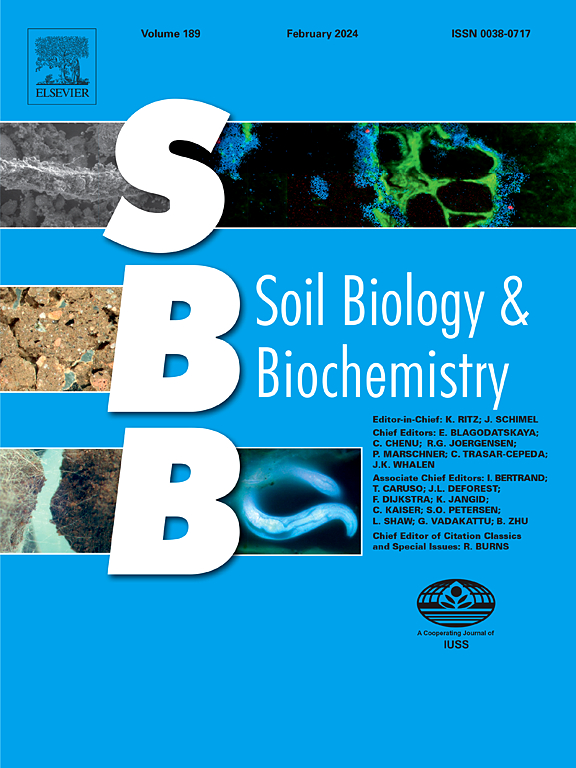共生硝化微生物群落对土壤干-再湿胁迫的抗性和恢复力
IF 9.8
1区 农林科学
Q1 SOIL SCIENCE
引用次数: 0
摘要
硝化作用,即氨通过亚硝酸盐氧化为硝酸盐,导致农业土壤中氮的流失。当硝化是一个两步过程时,它取决于氨氧化古菌(AOA)和细菌(AOB)之间的成功代谢相互作用,以及主要在硝化杆菌(NIB)和硝化螺旋菌(NIS)内的亚硝酸盐氧化细菌。然而,气候变化引起的干旱期对这些微生物群落的组成和共同关联以及氮的命运的影响尚不清楚。在这里,我们在一个微观实验中对四种不同的土壤进行了一个较长的或两个较短的干旱期(7 - 11%的持水能力),然后进行再湿润,以评估干燥-再湿润胁迫在功能行会中引发不同反应的假设,这是由于环境偏好和适应策略的差异。AOA对干燥最敏感,相对丰度呈下降趋势。与对照相比,这三种土壤的氨氧化率平均降低了27%。然而,我们观察到在再润湿一周后AOA几乎完全恢复。NIS,而非NIB,在实验过程中受到再湿润的强烈影响而没有恢复,显示出群落组成和相对丰度的变化,高达30%的asv受到影响。网络分析显示,干燥-再湿润以土壤依赖的方式影响氨和亚硝酸盐氧化剂之间的共同发生,可能表明它们的代谢相互作用的不稳定。总的来说,这项研究强调了考虑干旱等极端天气对土壤氮化物群落动态和土壤中氮的命运的重要性。本文章由计算机程序翻译,如有差异,请以英文原文为准。
Resistance and resilience of co-occurring nitrifying microbial guilds to drying-rewetting stress in soil
Nitrification, the oxidation of ammonia via nitrite to nitrate, contributes to nitrogen losses in agricultural soils. When nitrification is a two-step process, it depends on the successful metabolic interaction between ammonia oxidising archaea (AOA) and bacteria (AOB), and nitrite oxidising bacteria primarily within Nitrobacter (NIB) and Nitrospira (NIS). However, consequences of dry spells caused by climate change on the composition and co-associations of these microbial guilds and the fate of nitrogen remain unclear. Here we subject four distinct soils to either one long or two shorter drought periods (7–11 % water holding capacity) followed by rewetting in a microcosm experiment to evaluate the hypothesis that drying-rewetting stress triggers distinct responses in the functional guilds due to differences in environmental preferences and adaptation strategies. While AOB were highly resistant, AOA were the most sensitive to drying among the four guilds and decreased in relative abundance. This coincided with reduced ammonia oxidation rates in three soils by on average 27 % compared to the control. However, we observed almost full recovery of AOA one week after rewetting. NIS, but not NIB, were strongly affected by rewetting with no recovery during the experiment, showing shifts in community composition and relative abundance with up to 30 % affected ASVs. Network analysis revealed that drying-rewetting affected co-occurrences between ammonia and nitrite oxidisers in a soil-dependant manner, possibly indicating a destabilisation of their metabolic interaction. Overall, this study emphasises the importance to consider weather extremes like drought on soil nitrifier community dynamics and the fate of nitrogen in soils.
求助全文
通过发布文献求助,成功后即可免费获取论文全文。
去求助
来源期刊

Soil Biology & Biochemistry
农林科学-土壤科学
CiteScore
16.90
自引率
9.30%
发文量
312
审稿时长
49 days
期刊介绍:
Soil Biology & Biochemistry publishes original research articles of international significance focusing on biological processes in soil and their applications to soil and environmental quality. Major topics include the ecology and biochemical processes of soil organisms, their effects on the environment, and interactions with plants. The journal also welcomes state-of-the-art reviews and discussions on contemporary research in soil biology and biochemistry.
 求助内容:
求助内容: 应助结果提醒方式:
应助结果提醒方式:


